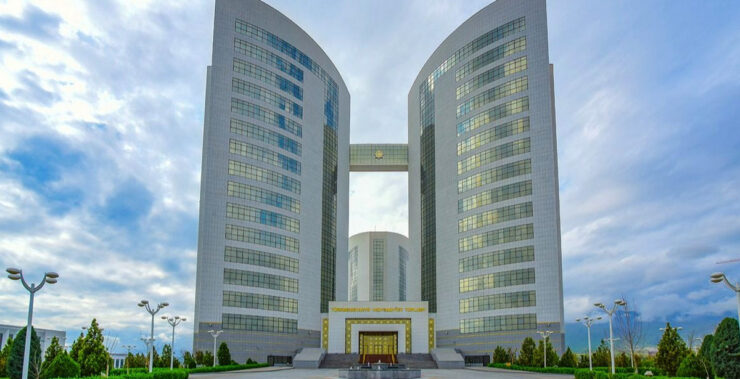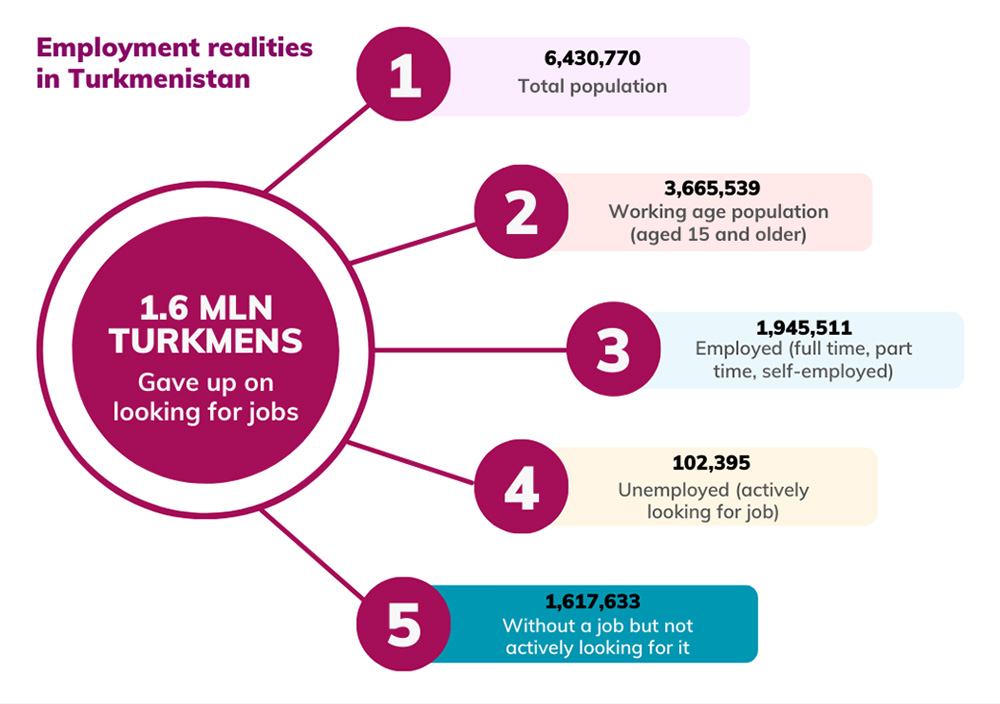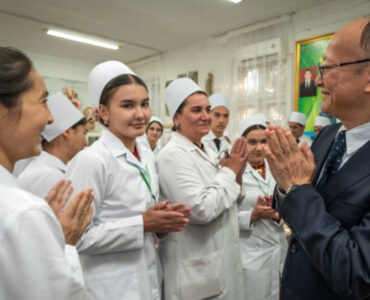In 2023, Turkmenistan exceeded its job creation target by nearly threefold, generating 7,607 new jobs compared to the planned 2,688, reports Orient. After having examined this data closely and put in light of the existing employment statistics, we found that job creation in Turkmenistan has declined over the past years, new jobs only met the needs of 7% of unemployed people and nearly half of the working age people simply gave up on employment.
Let’s look at the details.
What are the official employment statistics?
Neither the State Committee of Statistics nor the Ministry of Labour and Social Protection of Population in Turkmenistan report reliable and detailed employment data including the unemployment rate.
Turkmenistan’s state report to the United Nations International Covenant on Economic, Social, and Cultural Rights Committee submitted in 2016 and 2023 provide the following statistics:
- 57% of the total population in Turkmenistan are of working age (2022);
- 7.5% of people employed in the informal sector (2015);
- 42.6% of the economically active population are women (2015);
- 44.9% of the total number of people actually employed are women (2015).
The reports neither mention the rate of unemployment nor any problems associated with employment in Turkmenistan. As a response to Turkmenistan’s 2016 report, the UN Committee advised the State party to enhance its data collection, focusing on comprehensive, detailed statistics, including unemployment rates.
Moreover, the International Labour Organization (ILO) has made repeated unsuccessful attempts, starting in 2000, to reach out to the Statistical Committee of Turkmenistan to obtain data on various social and economic indicators, including the unemployment rate. All these failed attempts have been documented on the ILOSTAT page including the names of country representatives they have contacted.
What are the alternative sources of employment data?
Different sources report varying unemployment rates in Turkmenistan. According to Azatlyk, the country’s unemployment rate reached 60% in 2017 while Chronicles of Turkmenistan estimated it at 50% after having interviewed 212 individuals in 2017. Meanwhile, the US State Department’s Investment Climate Statements report in 2022 estimates unemployment rates between 10 to 50%. The report highlights that Turkmenistan faces significant unemployment and underemployment (workers unwillingly working in low-skill, low-paying and part-time jobs), especially among its youth and rural population.
Additionally, the World Bank is currently not publishing economic output, income, or growth data for Turkmenistan due to the lack of reliable data of adequate quality from the country. The World Bank only compiles some estimates based on the data from external sources such as ILO, IMF and UN. The IMF does not share any data on the unemployment rate in Turkmenistan and they recently published a case study on Turkmenistan suggesting and arguing that the country’s GDP numbers might be overestimated.
Unable to access reliable data from the government of Turkmenistan, the ILO computes its own modeled estimates of unemployment rates for the country. According to their recent data, the country’s unemployment rate was 5% in 2022, rising from 4.2% before the Covid-19 pandemic in 2019. Specifically in 2022:
Donate to support Turkmen analysts, researchers and writers to produce factual, constructive and progressive content in their efforts to educate the public of Turkmenistan.
SUPPORT OUR WORK- male unemployment – 6.7%;
- female unemployment – 3.6%;
- youth unemployment (ages 15-24) – 10.6%;
- youth male unemployment – 14.8%;
- youth female unemployment – 7.7%.
From the above data it looks like fewer women experience unemployment compared to men. However, the low rates of unemployment among the female workforce may be because they are not actively searching for employment as it is common for girls and women in Turkmenistan to engage in unpaid household activities and childrearing. Meanwhile, the gender pay gap persists in Turkmenistan as women earn 12.2% less compared to men (2022).
How can we make sense of the employment data?
To assess the adequacy of the newly created 7,607 jobs requires an understanding of the current unemployment rate, which is missing. Nevertheless, we can make revealing analysis using the currently available data.
First, as a comparison, Turkmenportal reported that 111,000 new jobs were created in Turkmenistan between 2015-2020 which equals to 18,500 new jobs per year for the given period. This means, creation of new jobs actually decreased over the recent years as there were 59% fewer jobs created in 2023.
Second, the labor force in Turkmenistan comprises 2,047,906 individuals out of a total population of 6,430,770 (World Bank projections for 2022), accounting for 31.8% of the population. The labor force includes both employed individuals, those actively seeking employment, and first-time job seekers. Given that 102,395 individuals are unemployed (actively seeking employment) and there are only 7,607 new jobs created, 93% of these people are still looking for jobs.
Third, the unemployment rate only encompasses individuals actively seeking jobs. While 57% of the total population in Turkmenistan are of working age (2022) only 31.8% are employed or actively looking for a job. This means, 44.1% of the working age people in Turkmenistan are not employed and not actively looking for a job (see the image below). In comparison, in Kazakhstan it is 13.2%.
There might be various reasons that explain this phenomenon including how optimistic people are about finding jobs. For example, in a 2022 survey conducted by the Central Asia Barometer only 5% of surveyed 1,621 people in Turkmenistan were optimistic about the state of the national economy and 2.8% were positive about jobs. This has to do with exorbitant bribes required for employment, difficulty for people from the regions to obtain a permit to work in Ashgabat, and constant pressure on state employees to donate their money to government initiatives, volunteer their time to clean the streets and give up personal freedoms.
Meanwhile, societal and cultural norms dictate that women should be a stay-at-home mom. Given these reasons many Turkmens, even those with full-time jobs, emigrate to Turkey, Russia, and other ex-Soviet states in search of better pay.
To conclude, the absence of an official and reliable unemployment rate necessitates reliance on external forecasts, creating transparency issues and conflicting estimates from other sources. With approximately 102,395 people actively seeking employment and only 7,607 lucky people finding jobs, the persistent gap highlights the enduring employment challenges in Turkmenistan.







